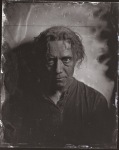‘Talking Heads, 1981’.
Apart from having a darkroom setup as a teenager (that was a few years ago !) this whole analogue photography experience is for me something relatively new. I have on occasions over the years put a few rolls of film through my old 35mm cameras that were kept for sentimental reasons but the majority of my personal work and all of my commercial work has until recent years been digital.
A few years back I ventured into the world of Alternative printing to try to create fine art prints with a more unique feel than digital. I started by having a go at Gum Bichromate printing which was something of a disaster with seeing most of my images wash down the drain during the development process. Undeterred and excited to enter the world of alternative processes I did some research into Salt printing which seemed to be more involved and some of the chemicals were not cheep but I found much of the work produced to be quite inspiring with incredible detail and fine tonal range.
My early works were created with digitally printed negatives from digital images, this is extremely common as it opens up the whole alternative process to virtually any image at any size but there was however a nagging thought in the back of my mind that there must be a more authentic way to produce my negatives. A year of experimentation with various small to medium and later on large format film cameras dropped me head first back into analogue capture and developing. There were many a ‘how do I …??’ conversation with fellow photographer Jo Cound whilst getting into trouble stinking out the house, that took me back to my childhood when my parents bought me a chemistry set, bad move Dad !
All going well until I wanted to create prints larger than 4”x5”, how did folk like Fox Talbot in the 1800’s create prints with such clarity before film was available, and many were 12” wide or even larger. Visiting ‘Salt and Silver : Early Photography 1840-1860’ exhibition at Tate Britain in 2015 was a turning point in my work giving me the answer. The glass plate negative.
In no time I was consuming YouTube videos and other resources to self teach the wet plate collodion process, a world filled with enthusiastic amateurs alongside present day masters of this Victorian process, each spending hours running the gauntlet of handling dangerous chemicals in air polluted dark rooms active in the pursuit of their individual creativity. I am a believer that whilst there is a wealth of great content in books and online there comes a time when we need the experience of seeing a process done (properly) by an expert and for me it was a day with David Gillanders in his studio in Glasgow. That was it I was now totally hooked with a new direction in my photography. Cheers David !
So, here I am today, still with more enthusiasm than hours in the day and a string of ‘one day’ ideas of which many will never get excersised but thats the beauty of analogue and alternative photography. Everything we know today has been the results of years of alchemists, scientists, artists and photographers playing, experimenting, failing and perfecting whilst generally following the ‘what happens if I do this…’ discipline.
Yes, the science and procceses are important although for me there’s is really no right or wrong way to do things, just the way that I do it to get the results that I like and often what may seem to be a failure at the time is actually a cue to try something different, one day !!












